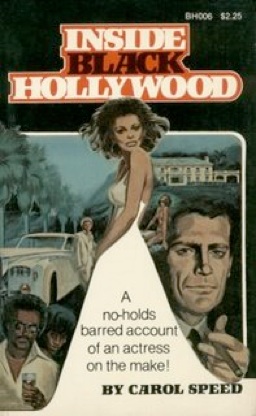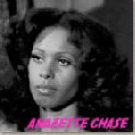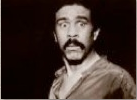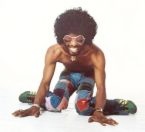“My friends admit I am black, beautiful and sometimes bitchy, but only when the situation calls for it. If life were a painting I’d be in the middle with a cynical little smile on my face and Hollywood in the background. My name is Dorothy Jean Dickerson. If the name isn’t familiar to you, my face and figure probably are. I’ve appeared in a number of ‘Black’ motion pictures — blaxploitation films some people call them — and my star is definitely on the rise.”
So begins Inside Black Hollywood, the first published novel by actress Carol Speed, who starred in THE MACK and a half-dozen other B-movies back in the early ’70s, but is mostly known these days for being mentioned in a Quentin Tarantino script TRUE ROMANCE.
A fictionalized account of the making of THE MACK — it’s called THE CHANCE here, with Ms. Speed telling the whole sordid story through her Dorothy Jean Dickerson persona — Inside Black Hollywood drops its readers headfirst into the mire of the ’70s exploitation movie scene and makes them swim with the sharks for 250 pages. Sure, all the names have been changed to protect the innocent (as well as the guilty, the stoned, and the just-plain-stupid), but you won’t need more than your two eyes and a copy of THE MACK to figure out who’s who.
First and foremost, there’s arrogant leading man Henry Worth (Max Julien), a borderline sociopath scheming to get Dorothy Jean fired from the film so his girlfriend — bitchy actress Lisa McLaine (Vonetta McGee) — can get the role instead.
Next on Speed’s shit list is producer Gerald Goldfarb (Harvey Bernhard), who overestimates Worth’s box-office worth and insists on kissing his ass instead of Dorothy Jean’s (Bernhard also produced Julien and McGee’s THOMASINE AND BUSHROD a year later).
Then there’s the director, Mark Katz (Michael Campus?), who’d rather bone every actress on the set than make a halfway coherent film. Oh, and let’s not forget the pathetic, self-pitying starlet Tanya Stevens (Annazette Chase), who screwed Mark to get a part in the movie — a part that’s getting smaller and smaller with every passing day — and out-of-control comedian Bubba Johnson (Richard Pryor), who’s on the skids because he told one too many “big dick” jokes in front of little old white ladies in Las Vegas and got his ass kicked out of town by the Mob.
And in the middle of it all is Dorothy Jean Dickerson, our lovely heroine and God’s gift to bargain basement cinema, who proves to be almost as obnoxious and egomaniacal as the others. When she isn’t fussing over her wardrobe and fighting with her costars, she’s either shoveling coke up her nose by the kilo or bitching endlessly about her shitty personal life and alienating everybody around her. Somehow, she manages to tear herself away from the mirror long enough to hook up with Fred Sullivan — underworld figure, player extraordinaire, and one of the shady Sullivan brothers, who are putting up the money to make the film. Fred’s character is based on Frank D. Ward, one of the Ward brothers, who financed most or all of THE MACK; he even appears in the film as himself, during the Players’ Ball scene (he’s the first runner-up after Goldie for the “Player of the Year” award). Speed obviously fell head over heels in love with Frank Ward, judging by the way Dorothy Jean literally (and repeatedly) soaks her panties at the mere mention of Fred Sullivan’s name. If you remember the dedication that appears at the beginning of THE MACK (“In memory of a MAN — Frank D. Ward”), you’ll know exactly where their relationship is headed.
“When I came to Hollywood everything began to happen for me almost immediately,” Speed told Black Stars magazine in 1980. “I was doing one film after the other and my career was moving forward at an extremely fast pace. Then all of a sudden this all ended. I must confess that much of it was my fault, because I committed several acts that contributed greatly to it.” Dorothy Jean’s behavior during the shooting of THE CHANCE certainly backs this up, but the loss of Frank D. Ward — more than any bridge burning that may have occurred during the making of THE MACK — was most likely what led Speed to start writing Inside Black Hollywood in 1974, under the title Dorothy Jean Dickerson – I Thought You Knew!
That same year, she had starring roles in ABBY and BLACK SAMSON, and then… nothing. She dropped out of the business and moved in with fading rocker Sly Stone, bringing only the clothes on her back and her unfinished manuscript. “For the most part, we stayed high from one day to the other,” she admitted to Black Stars when asked about this period in her life. “Time was of little importance, because one day was like the next one. I did absolutely nothing.”
She eventually wandered out of Sly’s compound and found her way back to her parents’ home in San Jose, where she sobered up and got her head together before returning to Los Angeles to finish her novel (probably in late 1978, since Dorothy Jean mentions Chaka Khan’s “I’m Every Woman” at one point).
Around this time, she also appeared in her last film to date, the Rudy Ray Moore jaw-dropper DISCO GODFATHER (1979).
Speed may have been a star on the rise when she made THE MACK in 1973, but by the time Holloway House published her book seven years later, her acting career was finished and the “Black Hollywood” of the title was just a memory.
A rumor in early 1997 had her joining two of her costars from THE BIG BIRD CAGE — Pam Grier and Sid Haig — in JACKIE BROWN, but the reunion never happened. She did contribute to the Tarantino-backed What It Is! What It Was! blaxploitation book in 1998, but was noticeably absent from the special edition DVD of THE MACK a few years later.
The whacked-out, paranoid bulletins that were emanating daily from her MySpace page seemed to be written by a person who either takes too much of the wrong kind of medication or not enough of the right. That’s a shame, because Speed’s a strong writer, and Inside Black Hollywood — when recognized as a work of nonfiction — is a fascinating and important contribution to B-movie history.

















